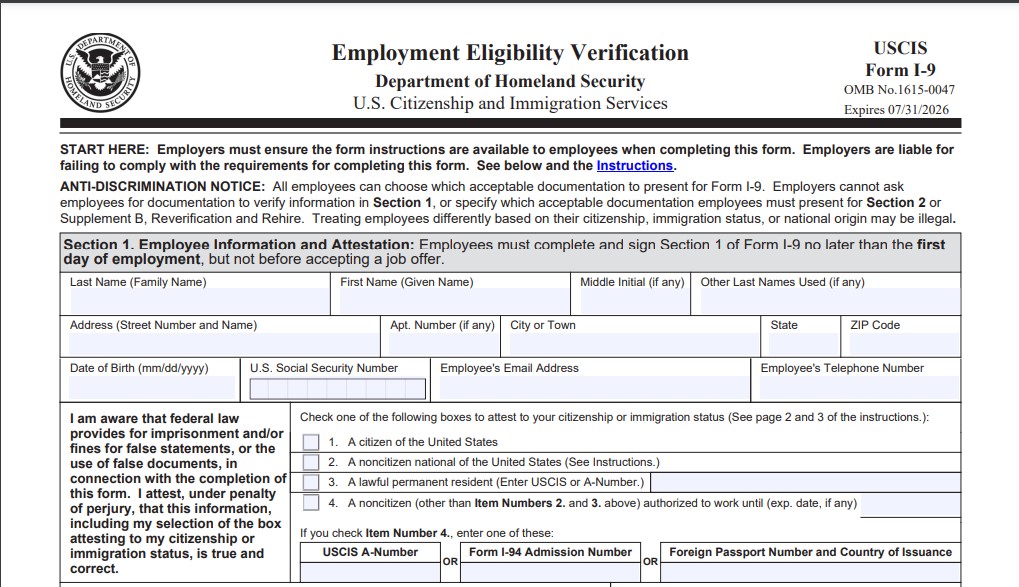The U.S. Citizenship and Immigration Services (USCIS) has, in recent times, implemented significant revisions to Form I-9. These updates have been thoughtfully designed to streamline procedures and ensure alignment with the evolving landscape of regulations.



The Significance of Form I-9
Form I-9 holds a pivotal role for employers throughout the United States. It is a mandatory process for all new hires, fulfilling dual objectives:
- Confirming the identity and employment eligibility of each employee.
- Shielding employers from the looming risk of fines and penalties tied to any violations of immigration regulations.
Changes in the New Form I-9
Commencing on November 1, 2023, employers must adopt the revised Form I-9. It’s essential to familiarize yourself with the primary alterations:
- New Expiration Date: The updated form now carries an expiration date of August 31, 2025. Employers must ensure that all employees hired before November 1, 2023, complete the new form by this date.
- E-Verify Section: The USCIS has included a new section for employers to indicate whether they are using E-Verify, an electronic employment eligibility verification system provided by the Department of Homeland Security.
- Revised List of Acceptable Documents: The new Form I-9 features an updated list of documents that employees can use to confirm their identity and employment eligibility. It’s essential for employers to familiarize themselves with these changes.
The updated Form I-9 list of acceptable documents has been revised to reflect changes in immigration law and identification procedures. Here are some of the key changes:
List A: Documents that establish both identity and employment authorization
- U.S. Passport or U.S. Passport Card
- Permanent Resident Card or Alien Registration Receipt Card
- Foreign passport with a temporary I-551 stamp or temporary I-551 printed notation
- Employment Authorization Document (EAD)
- Most recent USCIS Notice of Action (I-797) if it includes a photograph
List B: Documents that establish identity
- Driver’s license or ID card issued by a state or outlying possession of the United States, provided it contains a photograph or information such as name, date of birth, gender, height, eye color, and address
- ID card issued by federal, state, or local government agencies or entities
- School ID card with a photograph
- Voter’s registration card
- U.S. military card or draft record
- Military dependent’s ID card
- Native American tribal document
- U.S. Citizen ID Card (Form I-197)
- Identification Card for Use of Resident Citizen in the United States (Form I-179)
List C: Documents that establish employment authorization
- Social Security Account Number card, unless the card includes a legend stating, “NOT VALID FOR EMPLOYMENT”
- Certification of report of birth issued by the U.S. Department of State (Forms DS-1350, FS-545, FS-240)
- Original or certified copy of a birth certificate issued by a state, county, municipal authority, or outlying possession of the United States bearing an official seal
- Native American tribal document
- U.S. Citizen ID Card (Form I-197)
- Identification Card for Use of Resident Citizen in the United States (Form I-179)
Form I-9 and instructions should be carefully reviewed by employers to make sure they are accepting valid documents for employment eligibility verification.
- The USCIS has embraced a more inclusive approach in the updated form by substituting the word “alien” with “noncitizen.” This adjustment aligns with a more considerate and encompassing use of language.
Key Compliance Steps
To stay in accordance with immigration regulations, employers should take the following measures:
1. From November 1, 2023, onwards, utilize the revised Form I-9 for all newly hired employees.
2. Make certain that employees hired prior to November 1, 2023, have completed the updated form no later than the expiration date on August 31, 2025.
3. Acquaint yourself with the updated form and its corresponding guidelines, which can be easily obtained by downloading them from the USCIS website.
Conclusion
The latest updates to Form I-9 bring valuable changes that streamline the employment eligibility verification process. Employers should embrace these modifications to stay in compliance with immigration laws and protect their businesses from potential fines and penalties. Understanding and correctly implementing the changes in Form I-9 is not only a legal requirement but also a step towards promoting inclusivity and efficiency in your workplace. If you want to learn more about payroll from industry experts, watch the free webinars on our website.



